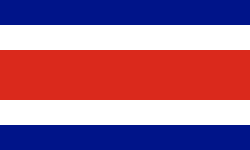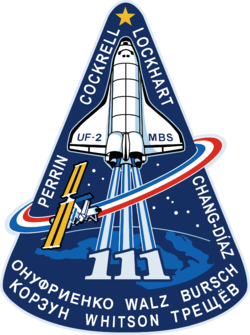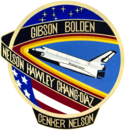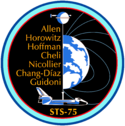Franklin Chang-Diaz
| Franklin Chang-Díaz | |
|---|---|
 Franklin Chang-Díaz | |
| Astronaut NASA | |
| Státní příslušnost | |
| Datum narození | 5. dubna 1950 (72 let) |
| Místo narození | |
| Čas ve vesmíru | 66 dní, 18 hodin a 16 minut |
| Kosmonaut od | 1980 |
| Mise | STS-61-C, STS-34, STS-46, STS-60, STS-75, STS-91, STS-111 |
| Znaky misí | |
| Kosmonaut do | 2005 |
| Pozdější zaměstnání | důchodce |
| Některá data mohou pocházet z datové položky. | |
Franklin Chang-Díaz (* 5. dubna 1950 v San José, stát Kostarika) je vědecký, řídící pracovník a americký kosmonaut. Ve vesmíru byl sedmkrát.
Život
Narodil se v hlavním městě Kostariky San José v dubnu 1950. Jeho otcem je Ramón A. Chang-Morales, matkou Maria Eugenia Díaz De Chang. Je vnukem čínského emigranta.
Studium a zaměstnání
Základní školu absolvoval v rodném městě, střední školu Hartford High Schooll už v USA absolvoval v roce 1969 a pak nastoupil k vysokoškolským studiím. Zakončil je získáním doktorátu v oboru aplikované fyziky plazmatu. Pracoval pak ve výzkumu, později se stal ředitelem Jet Propulsion Laboratory při Johnsonově vědeckém středisku a učil jako profesor na univerzitě v Houstonu.
Oženil se v Louisianě podruhé s Peggy Margueritou a je otcem čtyř dcer.
Lety do vesmíru
V květnu 1980 byl vybrán v rámci 9 náboru jako letový specialista do oddílu budoucích astronautů, v srpnu 1981 ukončil výcvik. Současně s tím pracoval ve výzkumu v různých odděleních týkajících se kosmu a NASA.
Na oběžnou dráhu se v raketoplánech dostal sedmkrát a strávil ve vesmíru 66 dní, 18 hodin a 16 minut. Absolvoval 3 výstupy do volného vesmíru (EVA) a strávil v něm přes 19 hodin. Byl 197. člověkem ve vesmíru.
- STS-61-C Columbia (12. leden 1986 – 18. leden 1986)
- STS-34 Atlantis (18. říjen 1989 – 23. říjen 1989)
- STS-46 Atlantis (31. července 1992 – 8. srpna 1992)
- STS-60 Discovery (3. února 1994 – 11. února 1994)
- STS-75 Columbia (22. února 1996 – 9. března 1996)
- STS-91 Discovery (2. června 1998 – 12. června 1998)
- STS-111 Endeavour (5. června 2002 – 19. června 2002)
Odkazy
Externí odkazy
 Obrázky, zvuky či videa k tématu Franklin Chang-Diaz na Wikimedia Commons
Obrázky, zvuky či videa k tématu Franklin Chang-Diaz na Wikimedia Commons - Na webu Space
- Web Kosmo
Média použitá na této stránce
STS111-S-001 --- The STS-111 patch symbolizes the hardware, people, and partner nations that contribute to the flight. The Space Shuttle rises on the plume of the Astronaut Office symbol, carrying the Canadian Mobile Base System (MBS) for installation while docked to the International Space Station (ISS). The mission is named UF-2 for ISS Utilization Flight number two. The ISS orbit completes the Astronaut Office symbol and is colored red, white, and blue to represent the flags of the United States, Russia, France, and Costa Rica. The Earth background shows Italy, which contributes the Multi Purpose Logistics Module (MPLM) used on this flight to re-supply ISS. The ten stars in the sky represent the ten astronauts and cosmonauts on orbit during the flight, and the star at the top of the patch represents the Johnson Space Center, in the state of Texas, from which the flight is managed. The names of the STS-111 crew border the upper part of the patch, and the Expedition Five (going up) and Expedition Four (coming down) crews’ names form the bottom of the patch. The NASA insignia design for Shuttle flights is reserved for use by the astronauts and for other official use as the NASA Administrator may authorize. Public availability has been approved only in the forms of illustrations by the various news media. When and if there is any change in this policy, which is not anticipated, the change will be publicly announced.
STS-60 crew patch
- The design of the crew patch for NASA's STS-60 mission depicts the Space Shuttle Discovery's on-orbit configuration. The American and Russian flags symbolize the partnership of the two countries and their crew members taking flight into space together for the first time. The open payload bay contains: the Space Habitation Module (Spacehab), a commercial space laboratory for life and material science experiments; and a Getaway Special Bridge Assembly in the aft section carrying various experiments, both deployable and attached. A scientific experiment to create and measure an ultra-vacuum environment and perform semiconductor material science – the Wake Shield Facility – is shown on the Remote Manipulator System (RMS) prior to deployment.
STS-34 Mission Insignia
S97-06573 (30 April 1997) --- Astronaut Franklin R. Chang-Diaz, mission specialist.
STS-46 Mission Insignia
STS-91 CREW INSIGNIA (March 1998) --- This is the crew patch for the STS-91 mission -- the ninth flight of the Shuttle-Mir Phase One docking missions. The crew will bring back Andrew S. W. Thomas, the last long-duration American crew member flown on the Russian Space Station Mir. This mission marks the end of the Shuttle-Mir Phase One Program and will open the way for Phase Two: construction of the International Space Station (ISS). The crew patch depicts the rendezvous of the Space Shuttle Discovery with the Space Station Mir. The flags of the United States and Russia are displayed at the top of the patch and both countries are visible on the Earth behind the two spacecraft. The names of the American crew members surround the insignia on the outer areas, with the name of cosmonaut Valery Ryumin in Cyrillic at the lower right. The Alpha Magnetic Spectrometer (AMS) is an international payload planned to fly in the payload bay of Discovery. Two thin golden streams flowing into the AMS represent charged elementary particles. The detection of antimatter in space will help scientists better understand the physics and origins of the universe.
STS-61-c mission patch
- Columbia, which opened the era of the Space Transportation System with four orbital flight tests, is featured in re-entry in the emblem designed by the STS-61C crew representing the seven team members who manned the vehicle for its seventh STS mission. Gold lettering against black background honors the astronaut crewmembers on the delta pattern surrounding colorful re-entry shock waves, and the payload specialists are honored similarly below the sphere.
STS-75 Mission Insignia









